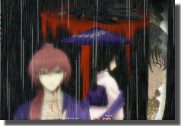![]()
![]()

Rurouni Kenshin
(Samurai X)
Tsuiokuhen 1: Kiru Otoko
© Watsuki Nobuhiro / SPE Visual Works / Shueisha / FUji TV
© 2000 ADV Films
Color / Stereo / 30 minutes / Japanese Language / English Subtitles
![]()
An attack on a group of travellers results in the death of almost everyone involved. Watching most of the group get killed, young Shinta thinks to protect 3 young girls in the group. Akane, Kasumi and Sakura however have other ideas protecting young Shinta with their very lives. Shinta, facing sure death is spared by the arrival of Hiko Seijiro, a lone swordsman following the Hiten Mitsurugi Ryu school of swordsmanship. After saving young Shinta, Seijiro tells the young boy to accept the deaths as there is no way to bring back the dead. Death was an all too common event in Edo Japan during the Bakumatsu.
A few days later after buying sake, when passing the site of the attack, Seijiro finds that young Shinta had dug graves for all of the deceased. Seijiro, after talking to young Shinta, decides to take him on as an apprentice to the Hiten Mitsurugi Ryu school and renames him Kenshin...
The year is now 1864, and young Kenshin walks the night streets of Kyoto in search of his nightly victims. One of Kenshin's victims, Kiyosato Akira, despite being severely injured struggles to live on, and ends up cutting Kenshin on his cheek. Young Kiyosato's last thoughts before dying is on his young fiancee. Young Kenshin finds that following every assignment thereafter, the cut on his cheek bleeds as a reminder from someone who had been killed by Kenshin and as a reminder of someone who's future had been destroyed as well as the happiness of those around him. The Hiten Mitsurugi Ryu school of swordsmanship is for protecting people; and young Kenshin is wondering if his killing people on a nightly basis is truly helping to protect people.
Memories from before becoming a hitokiri plague Kenshin. His parting with his swordmaster Hiko Seijiro and the reasons for Kenshin wanting to leave the mountain where he learned to wield a sword and his last words with his master are fresh in Kenshin's mind. Kenshin is especially reminded of Seijiro's words, that the art of the sword is the art of murder; and this disturbs him. Truly all he has been doing has been killing people.
The memory of when Kenshin was first approached by Katsura provides a counter to his memories of Hiko Seijiro. Katsura suggests that in order to bring in a new era, one must first destroy the old; and to do that, one may therefore need to kill others. When asked if he would be able to kill people to bring about change, Kenshin decides to join Katsura as a hitokiri to try and serve the greater good as he saw it.
Young Kenshin, during an ambush on the streets in Kyoto, meets young Yukishiro Tomoe. Tomoe, a young lady who had been drinking alone in an Izakaya greets the young swordsman saying "Anata honto ni furasuno desune; chi no ame" (you truly bring it down; bloody rain).
![]()
- Himura Kenshin: Suzukaze Mayo
- Shinta: Suzuki Shinji
- Yukishiro Tomoe: Iwao Junko
- Hiko Seijuro: Ikeda Shuichi
- Katsura Kogorou: Seki Tomokazu
- Saito Hajime: Suzuoki Hirotaka
![]()
- Director: Furuhashi
- Story and Original Character Design: Watsuki Nobuhiro
- Produced by: Fuji TV / SPE Visual Works
[ << prev ] [ top ] [ next >> ]
[ home ]
[ what's new ]
[ café contest ]
[ café reviews ]
[ parent's guide ]
[ encyclopædia ]
[ café trivia ]
[ café latté ]
[ café espresso ]
[ about the café ]
[ feedback ]
[ links ]
[ site map ]
© 1997-2001. All rights reserved. The Animé Café logo and the Crystal Kyoko award are original creations of the Animé Café. Please do not use any of the materials on this site without the expressed written permission of the Animé Café.
Page last modified 2001.10.15
